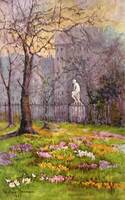A well-known passage occurs in Evelyn's Diary, 1664, where he enumerates some of the birds and beasts he saw during one of his walks through the Park. The pelican delighted him, although "a melancholy waterfowl," and he watched the skilful way it devoured fish; and it is not surprising that he recorded the strange fact that one of the two Balearian cranes had a wooden leg, made by a soldier, with a joint, so that the bird could "walk and use it as well as if it had been natural"; and he speaks with interest of a solan goose, a stork, a milk-white raven, and "a curious sort of poultry," besides "deer of several countries," antelopes, elk, "Guinea goats, Arabian sheep, etc." The duck decoy lay at the south-west end of the long canal, which formed part of the new French design. This "duck island" was rather a series of small islands, as it was intersected by canals and reed-covered channels for catching duck. This was a favourite resort of Charles II., who has often been described feeding his ducks in St. James's Park. To be keeper of the ducks, or "Governor of Duck Island," was granted to St. Evremond, an excuse for bestowing a yearly salary on a favourite. The birds continued after the King, who had found in them a special recreation, had passed away. In William III.'s time the Park is still described as "full of very fine walkes and rowes of trees, ponds, and curious birds, Deer, and some fine Cows." A Dutch traveller who was in England from 1693-96 notices the famous old white raven. By that time the ducks were no longer the fashion, and evidently there was an inclination to despise the former craze for wild fowl. A Frenchman, named M. de Sorbiere, visited England about this time, and wrote an account of his impressions. Some of his adverse criticisms of English people and institutions got him into trouble. A supposed translation of his book was published in 1698, and until 1709 was held to be a correct version. In reality it was a clever skit, and not in the least like the original. In the true version he describes the Park with its rows of trees and "admirable prospect" of the suburbs, and mentions that the King had "erected a tall Pile in the Park, the better to make use of Telescopes, with which Sir Robert Murray shew'd me Saturn and the Satellites of Jupiter." Not a word about the ducks. But in the spurious parody of 1698 there is a humorous description, which shows how the next generation laughed at the amusements of King Charles II. "I was at St. James's Park; there were no Pavillions, nor decoration of Treilliage and Flowers; but I saw there a vast number of Ducks; these were a most surprising sight. I could not forbear to say to Mr. Johnson, who was pleased to accompany me in this Walk, that sure all the ponds in England had contributed to this profussion of Ducks; which he took so well, that he ran immediately to an Old Gentleman that sate in a Chair, and was feeding of 'em. He rose up very obligingly, embraced me, and saluted me with a Kiss, and invited me to Dinner; telling me he was infinitely oblig'd to me for flattering the King's Ducks."
Little attention was paid to the wild fowl in the Park after that date, until the Prince Consort took an interest in them. In 1841 he became the Patron of the Ornithological Society, and the cottage on Duck Island was built for the Bird-keeper. For some thirty years the Society flourished, and kept up the supply and cared for the birds in the Park. In 1867, however, their numbers were greatly reduced, and the Society sold their collection of birds to H.M. Office of Works, which has since then had them under its charge. It is pleasant to know that the old tradition of the wild fowl in that part of the Park is maintained. Although the duck pond of King Charles's time must have looked somewhat different from that of to-day, the birds can be made as much at home, and they nest peacefully on the modern Duck Island, its direct descendant. Moorhens and dabchicks, or little grebes, have for the last twenty years nested in the Park. They used to leave for the breeding season, but since 1883, when the first moorhen nested, they have gradually taken to remaining contentedly all through the year, and bring up their young there. Birds seem to choose the Park to rest in, and many migratory ones have been noticed. Kingfishers have recently been let out near the site of the ancient bird cages, in the hope that they may carry on the historic association.

